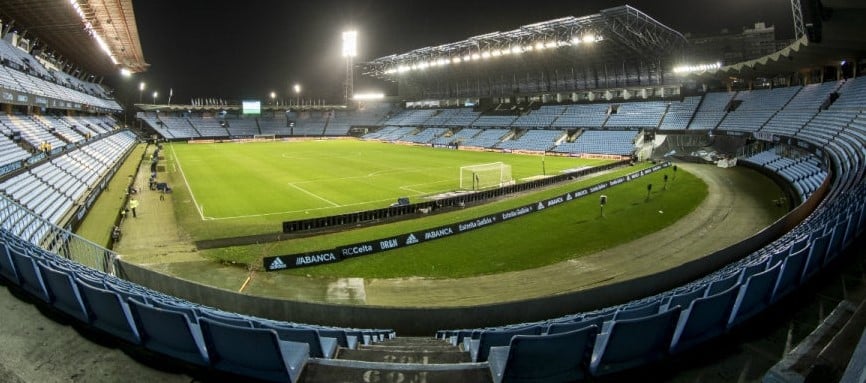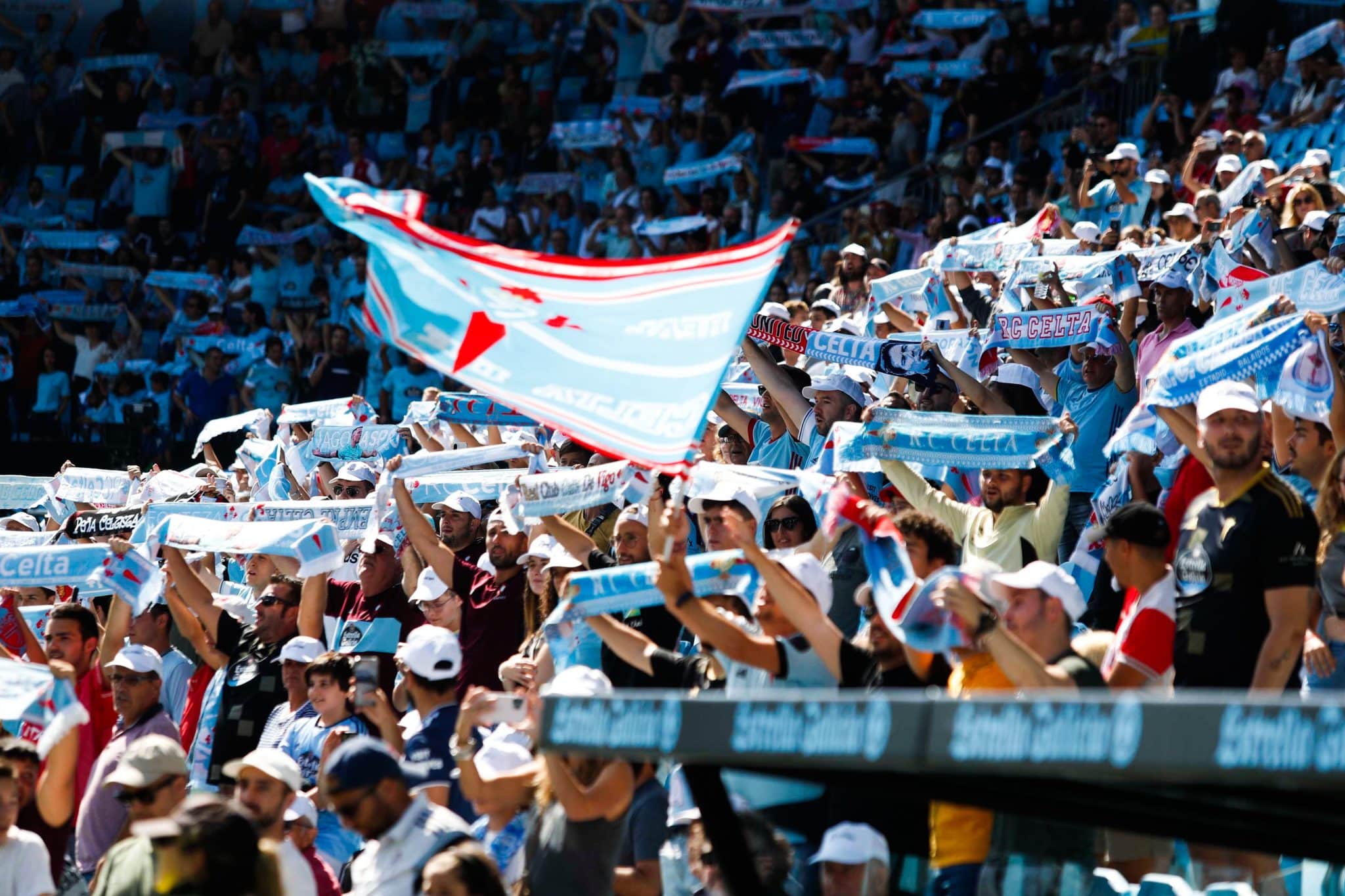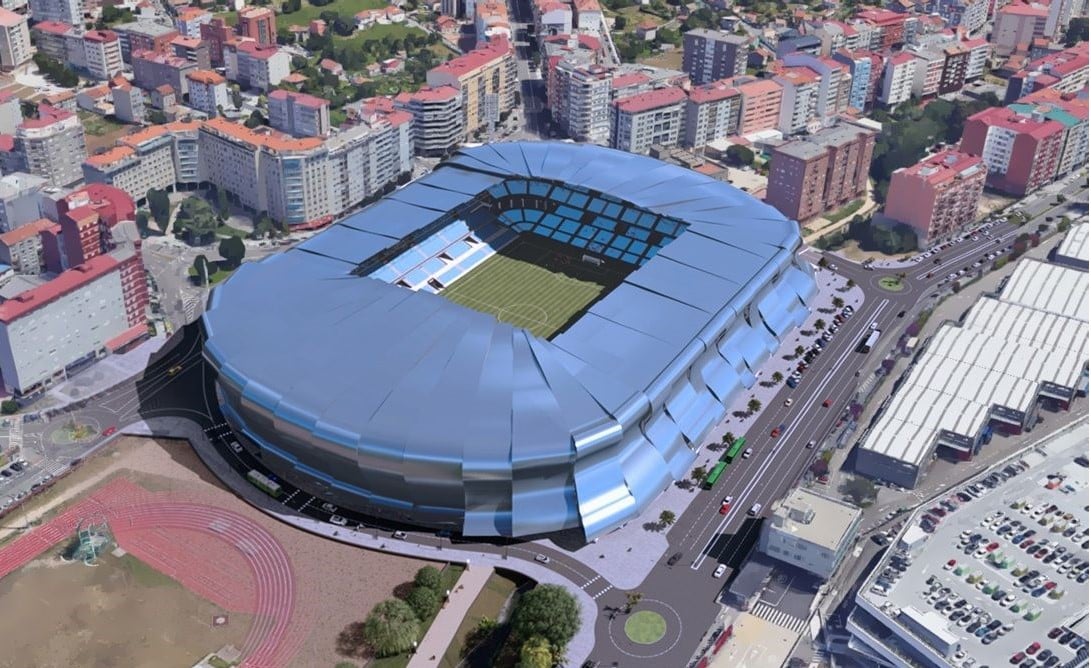Estadio Municipal de Balaídos is a modern facility that underwent a major renovation between 2015 and 2021. Not only was the capacity expanded from 24,791 to 31,800 during these latest renovations, but Stadium Balaídos was converted into a modern football ground that uses mainly solar energy for its needs.

Since the latest renovations, the access for disabled people to Celta Vigo’s stadium has improved a lot, too. No matter the disability, now everyone can attend and enjoy a football game.
There are four distinct Stands.
The Tribuna Stand runs parallel to the pitch. This is where all the VIP Boxes and Media seats are located. Also, this is where the fans can find the Celta Vigo Bar.
Opposite it, on the other side of the pitch, is another two-tier stand called Rio Alto.
The main ticket office and entrance, right next to which is the new Celta Vigo Museum, is located at the Grada Gol Stand. This is where the most passionate of home fans are usually located, right behind one of the goals.
Opposite that is the only one-tier stand left. The Marcador Stand is designated for away fans and has only since 2021 finally had a roof to shelter the supporters from blazing sun or heavy rain.
The roar of Balaidos is never just about the football, it’s about the passion, identity and culture of Galicia flowing through the voices of Celta Vigo supporters. Matchdays in Vigo are lit up by chants that blend pride in the club with regional spirit, sung loud by Celtarras ultras and echoed by thousands of fans.
These songs don’t just lift the team; they bind the community together, reminding everyone that Celta Vigo is more than a club, it’s a way of life.
Here are some of the most iconic chants you will hear ringing out from the stands:
- Este Celta se rinde
- Celta au te quero
- Oliveira dos cen anos
- Celta campion
- Que viva Balaidos
After the most recent renovation, Stadium Balaídos has its own Celta Vigo Bar, so drinks and snacks can be found there.
Outside the stadium, the options are not that rich. ‘Bunny’ is the pub located closest to the grounds. It sells beers and spirits, and despite not being great, it has its advantages as it is only a 5-minute walk from Stadium Balaídos.
The favourite among locals’ pub before and after games is located about a 20-minute walk from Celta Vigo’s stadium, and it is called ‘El Encuentro’. Its atmosphere is great, and most locals praise its food too.
By bus and train
Urzaiz train station, Vigo’s main train station, is located about 5 km away from the Celta Vigo stadium. On foot, it will take only 45 minutes to cover the distance, and it’s worth it as the walk will take you through the historic town centre and offer you the opportunity to explore some of the main attractions of this part of Galicia, outside football.
For those who opt to take a taxi from the train station to Stadium Balaídos, it should take about 15 minutes and the price will be around €20.00.
Bus connections are also a possibility. All of the following bus lines, 5a, 7, 8, 11, 12b, and 17 are useful and will get you right to Stadium Balaídos.
By car
The stadium is not far away from the main high-speed road of Galicia, VG-20. Once close to Vigo, look for the signs directing towards Celta Vigo’s stadium and take one of the several exits available.
Then all you need to do is follow one of the Rúa de Citroën or Rúa Val Miñor, depending on which exit you’ve entered Vigo, and this should take you right to the football ground.
The parking options near Stadium Balaídos are limited. Only a small number of parking spaces are available, and generally, the local council prefers visitors to use public transport and not block the streets and pavements around Celta Vigo’s stadium with vehicles.

Full capacity: 31,800
Home seats: 27,325
Away seats: 4,775
Space for wheelchair users: 75
Media seats: 45
When was Stadium Balaídos built?
It was built between 1925 and 1928.
Other uses for Stadium Balaídos?
In terms of sports, Stadium Balaídos is used only for football. The Celta Vigo stadium is also used for concerts from time to time. The first-ever concert was on 26 August 1983 when Miguel Rios performed.
The story of Stadium Balaídos
Way back in 1924, a group of local Galician businessmen bought a piece of land (75,000 sq m) between 1925 and 1928, and they built Stadium Balaídos.
The first match was played on 30 December 1928, and it saw the only football team to ever use this stadium as a permanent home, Celta Vigo beat Real Union 7-0.
In 1967, the stadium was expanded with an extra stand. The second major expansion was in 1982 in preparation for the 1982 World Cup, as Celta Vigo’s stadium was one of the grounds used for that tournament. This latest expansion brought the highest-ever attendance recorded at Stadium Balaídos. In May 1982, in a Secunda Division match, Celta Vigo vs Getafe, 45,000 fans were in attendance.
Since then, Stadium Balaídos has been reduced in capacity several times as it is unsustainable for the ground to be that big when the average attendance has never been higher than 24,000.
In recent years, between 2015-18 and 2019-21, Celta Vigo’s stadium was modernised a lot, and right now it looks very slick and modern facility.

Celta Vigo’s official website offers various options for Stadium Balaídos tours. Those are usually conducted on days on which there are no scheduled matches.
As of 2019, Celta Vigo also has a Stadium Museum open for visits. It is located at the entrance of the ‘Grada Gol’ Stand and is usually open 6 days a week, including on matchdays. No advanced bookings are needed to visit the Celta Vigo Museum.
Celta Vigo’s main local rival is Deportivo La Coruna.
The two clubs contest the Galician Derby, also known as O Derbi Galego, one of Spain’s most passionate regional rivalries. It is rooted not only in the footballing competition but also in cultural and regional pride, with Vigo and Deportivo La Coruna being Galicia’s two largest cities.
Matches between Celta and Deportivo often carry an atmosphere that goes beyond the pitch, symbolising bragging rights for their respective cities and fanbases.
Over the years, the rivalry has produced unforgettable encounters filled with drama, passion and intensity, regardless of whether the teams are competing in La Liga or the lower divisions.
Real Sociedad, Real Oviedo, Sporting Gijon and Sevilla are other notable Celta rivals.
Matchday tickets can be purchased online on the Celta Vigo website, or as is often the case, directly from the Club’s Shop and the ticket offices at the gates of the stadium. Celta Vigo’s Stadium Balaídos matches rarely sell out, so one can usually buy a ticket from the gates right up until kick-off time.
The price of tickets varies from as low as €20.00 for the upper tiers to as much as €110.00 for VIP box accommodation.
Reviews
Be the first to leave a review of Celta Vigo (Stadium Balaídos)!
Why not write your own review of this ground and have it included in the Guide? Find out more about submitting a Fans Football Ground Review.